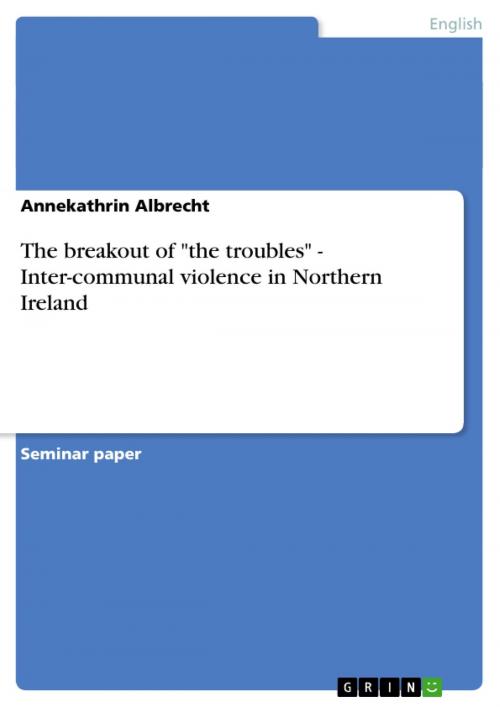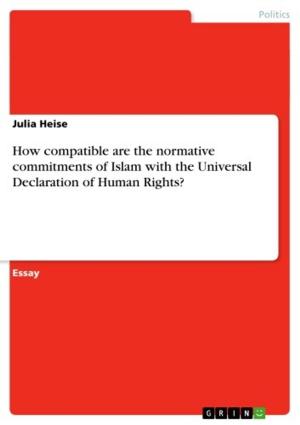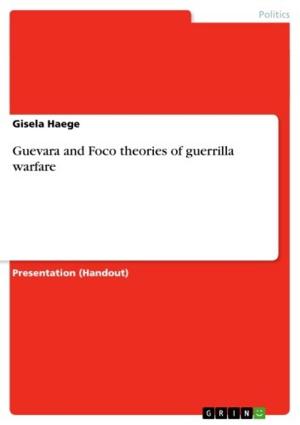The breakout of 'the troubles' - Inter-communal violence in Northern Ireland
Inter-communal violence in Northern Ireland
Nonfiction, Reference & Language, Study Aids, ESL, Foreign Languages| Author: | Annekathrin Albrecht | ISBN: | 9783638036092 |
| Publisher: | GRIN Publishing | Publication: | April 14, 2008 |
| Imprint: | GRIN Publishing | Language: | English |
| Author: | Annekathrin Albrecht |
| ISBN: | 9783638036092 |
| Publisher: | GRIN Publishing |
| Publication: | April 14, 2008 |
| Imprint: | GRIN Publishing |
| Language: | English |
Seminar paper from the year 2007 in the subject English Language and Literature Studies - Culture and Applied Geography, grade: 2,0, Martin Luther University, 15 entries in the bibliography, language: English, abstract: The origins of the conflict in Northern Ireland are various and can be traced back to the seventeenth century. In the following work I explore the period from the late 1960s to the early 1970s with focus on the segregation issue of the Protestant and Catholic communities, its settings and reasons. Furthermore the social cohesion of the paramilitary groups and 'their' communities is a discussed aspect. The conflict in Northern Ireland has a complex and deeply rooted history. My intention in writing about the start-up period of the inter-community violence in Northern Ireland was to give a deeper insight into this structure. Following the statements of sociologists, the violence in Northern Ireland can be regarded as 'a surface expression of 'deeper' socio-economic and/or ideological contexts.' Hence the outbreak of rioting in the late 1960s can be considered as a desperate attempt of an oppressed minority to acquit itself from a discriminating majority. Violence in Northern Ireland was a cycle of provocation and reaction, of misunderstanding and discrimination. It is a matter of fact that violence provokes violence in turn and that prejudices are handed over from one generation to the following generation. Cumulative factors to the violence were, inter alia, the direct involvement of British troops, a Northern Irish police force which was biased against Catholics, provocations running out from the opposing camps and a British security-policy, primarily directed against Catholics, which seemed to be the case especially at the beginning of the conflict. The following work contains an overview about the historical origins of the conflict and a description of the main conflict parties inclusive the paramilitaries and leads then to the outbreak of 'the Troubles' and the first years of violence. The last chapter explores some facts of the segregation between Protestant and Catholic communities.
Seminar paper from the year 2007 in the subject English Language and Literature Studies - Culture and Applied Geography, grade: 2,0, Martin Luther University, 15 entries in the bibliography, language: English, abstract: The origins of the conflict in Northern Ireland are various and can be traced back to the seventeenth century. In the following work I explore the period from the late 1960s to the early 1970s with focus on the segregation issue of the Protestant and Catholic communities, its settings and reasons. Furthermore the social cohesion of the paramilitary groups and 'their' communities is a discussed aspect. The conflict in Northern Ireland has a complex and deeply rooted history. My intention in writing about the start-up period of the inter-community violence in Northern Ireland was to give a deeper insight into this structure. Following the statements of sociologists, the violence in Northern Ireland can be regarded as 'a surface expression of 'deeper' socio-economic and/or ideological contexts.' Hence the outbreak of rioting in the late 1960s can be considered as a desperate attempt of an oppressed minority to acquit itself from a discriminating majority. Violence in Northern Ireland was a cycle of provocation and reaction, of misunderstanding and discrimination. It is a matter of fact that violence provokes violence in turn and that prejudices are handed over from one generation to the following generation. Cumulative factors to the violence were, inter alia, the direct involvement of British troops, a Northern Irish police force which was biased against Catholics, provocations running out from the opposing camps and a British security-policy, primarily directed against Catholics, which seemed to be the case especially at the beginning of the conflict. The following work contains an overview about the historical origins of the conflict and a description of the main conflict parties inclusive the paramilitaries and leads then to the outbreak of 'the Troubles' and the first years of violence. The last chapter explores some facts of the segregation between Protestant and Catholic communities.















